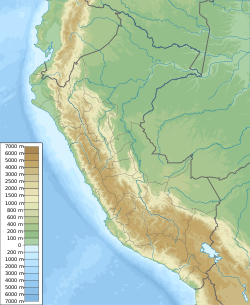Top Qs
Timeline
Chat
Perspective
Pisco Basin
Peruvian sedimentary basin From Wikipedia, the free encyclopedia
Remove ads
Pisco Basin (Spanish: Cuenca de Pisco) is a sedimentary basin extending over 300 kilometres (190 mi) in southwestern Peru.[1] The basin has a 2-kilometre (1.25-mile) thick sedimentary fill, which is about half the thickness of more northern foreland basins in Peru.[2]
The oldest known sediments are the Eocene sandstones of the Caballas Formation, while the youngest deposits, the fossiliferous Pisco Formation, date to the Early Pleistocene.[2][note 1] In relation to present-day, topography the fill of Pisco Basin makes the upper part of the Coastal Cordillera of southern Peru, the coastal plains, the Ica-Nazca Depression and the Andean foothills.[3]
The basin is renowned for hosting various highly fossiliferous stratigraphic units; the Pisco Formation has provided a wealth of marine mammals (including sloths), birds, fish and other groups, as have the Chilcatay, Otuma and Paracas Formations.
Remove ads
Stratigraphy
Remove ads
Tectonic and sedimentary evolution
Summarize
Perspective
The basin developed in a setting of extensional tectonics from Eocene to the Late Miocene with short-lived episode of basin inversion in the Middle Miocene.[7] Late Pliocene and Pleistocene uplift of the basin may be consequence of the subduction of Nazca Ridge.[2][8]
Sedimentary strata of the basin shows evidence for a series of marine transgressions during the last 50 million years.[9] These marine transgressions occurred in a sequence 41-34 Ma, 31-28 Ma, 25-16 Ma, 15-11 Ma, 10-5 Ma, and 4-2 Ma.[9] The end of most of the marine transgressions is thought to be associated either with global sea level falls or compressional events in the Andes.[9]
Oligo-Miocene transgression
The marine Oligo-Miocene (25–16 Ma[9]) marine transgression is evidenced by a series of sedimentary strata containing fossils of marine diatoms, Peruchilus snails and Pitar and Cucullaea clams.[10] Oligo-Miocene marine environments in the Pisco Basin range from littoral to shelf.[10] Moquegua Basin southeast of Pisco Basin appear to have been unaffected by the transgression.[10]
Within the Andean margin contemporary marine transgressions are also known from southern Chile, Patagonia and Colombia.[10] As such the marine transgression is thought to represent a regional phenomenon with the steadily rising central Andes being an exception.[10]
Remove ads
Paleontology
Pisco Formation
Chilcatay Formation
Otuma Formation
Paracas Formation
See also
- Arauco Basin, Chile
- Altiplano Basin, Peru, Chile, Bolivia
- Caldera Basin, Chile
- Cocinetas Basin, Colombia
- Urumaco Formation, Venezuela
Notes and references
Further reading
Wikiwand - on
Seamless Wikipedia browsing. On steroids.
Remove ads
